Air Defense History: Talos, Terrier and the Standard Missile
At the close of WW II, the Empire of Japan sent suicide planes at US Navy ships in a desperate attempt to stop the war. While aircraft and AAA stopped many kamikaze aircraft, the Navy wanted a surefire defense against hostile aircraft.
Operation Bumblebee developed and tested US Navy ramjet missiles at the end of World War II. The Applied Physics Lab PTV-N-4 Cobra/BTV was flown in October 1945,[1] and the program developed the operational RIM-8 Talos missile.
The Talos missile was the first US naval surface to air missile. However, due to technology at the time, it was huge. At 11.6 meters, it was 1.5 meters shorter than the Soviet MiG-15’s that is was designed to shoot down. The ships that carried the missile were: three converted Cleveland class light cruisers (USS Oklahoma City, Galveston, and Little Rock), and the converted Baltimore class heavy cruisers Albany, Chicago, Columbus and the nuclear-powered USS Long Beach. It was large, bulky and expensive, but Chicago and Long Beach shot down three Migs in Vietnam. Like Nike, there was a nuclear armed version of the missile. When the Long Beach was decommissioned in 1979, the missile was phased out.
As the 1950’s went on, the Talos was complemented by the Convair RIM-2 Terrier:
… a two-stage medium-range naval surface-to-air missile (SAM), and was among the earliest surface-to-air missiles to equip United States Navy ships. Originally, the Terrier had a launch thrust of 23 kN (5,200 lbf), and weight of 1392 kg (3,069 lb). Its original dimensions were a diameter of 340 mm, a length of 8.08 m, and a fin span of 1.59 m.
As part of a layered approach to air defense, this missile was designed to be deployed on all Navy cruisers built during the 1960s. Tested on the USS Mississippi (AG-128) ex (BB-41), and first deployed on the Boston class cruisers, USS Boston (CAG-1) and USS Canberra (CAG-2). It had a nuclear armes version (again like Nike). It was in service until the Standard missile came on line. Smaller ships even had a mini-me version, the RIM-24 Tartar.
As the cold war went on, the Standard missile was developed to replace the “three T’s” (Talos, Terrier and Tartar). Soviet bombers and fighters had evolved. This missile came in several flavors. Standard Missile 1 was a replacement for the Tartar, it even used it’s fire control system. Standard Missile 2 was developed as part of the AEGIS system. They were baptized by fire quickly:
The Standard missile one became operational in 1968. The missile was utilized by ships equipped with the Tartar Guided Missile Fire Control System. The missile saw its first combat use in the early 1970s in the Vietnam war. The Standard missile two became operational in the late 1970s and was deployed operationally with the Aegis Combat System in 1983. Both Standard one and two were used against both surface and air targets during Operation Praying Mantis. On 3 July 1988, USS Vincennes (CG-49) shot down Iran Air Flight 655, an Airbus A300B2, using two SM-2MR missiles from her forward launcher.[5
The RIM-67 Standard missile had a rocket booster. With more range it replaced the Talos missile. It could even attack surface ships:
During the Iran–Iraq War the United States had deployed Standard missiles to protect its navy as well as other ships in the Persian Gulf from Iranian attacks. According to the Iranian Air Force, its F-4 Phantom IIs were engaged by SM-2ERs but managed to evade them, with one aircraft sustaining non-fatal damage due to shrapnel.[3]
A view of an RIM-67B Standard (SM-2ER) surface-to-air missile on its launch platform aboard a guided missile cruiser
On 18 April 1988, during Operation Praying Mantis, the USS Simpson (FFG-56) fired four RIM-66 Standard missiles and the USS Wainwright (CG-28) fired two RIM-67 Standard missiles at Joshan, an Iranian (Combattante II) Kaman-class fast attack craft. The attacks destroyed the Iranian ship’s superstructure but did not immediately sink it. (It went down later.)
The Long Beach received this missile in place of her Talos missiles. Other ships included were: Leahy class cruisers SM-1ER later SM-2ER with NTU., USS Bainbridge (CGN-25) SM-1ER later SM-2ER with NTU, Belknap class cruisers SM-1ER later SM-2ER with NTU, USS Truxtun (CGN-35) SM-1ER later SM-2ER with NTU. WHile the AEGIS system has become synonymous with the Standard, the older Terrier and Tartar ships were given the New Threat Upgrade. This system was not as fast as AEGIS in many areas, but in others it was actually better than the early versions. It bridged the gap between modern AEGIS ships and the older vessels.
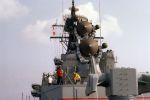
twin SPG-55B fire control radar systems, Mark 10 Mod O Terrier/Standard missile launcher is in the foreground.
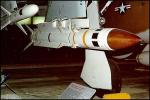
General Dynamics AGM-78 Standard ARM (Antiradiation Missile) at the National Museum of the United States Air Force.
In time the AEGIS system replaced the Terrier and Tartar ships. The Standard missile would evolve to even have an Anti-Ballistic Missile variant. This was becasue of work done with Terrier and Talos. They were fired at early Army ballistic missiles.
I have a personal connection to these missiles. My father worked on a radar that used to be a Navy AN/SPG-51. He was at White Sands Missile Range. He tracked many targets, including the Space Shuttle with that old radar. The radar was retired after many years and sadly my father has passed away, but now I am carrying on the tradition. I work with Patriot in the US Army.

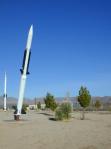




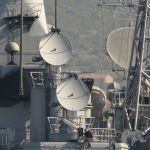
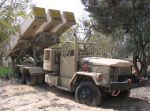
11, June 2009 at 3:47 am
The Tartar wasn’t so much just a mini-me of the Terrier. It started out as the sub-scale flight test model for Terrier. It worked so well, the Navy started a program built around its airframe and Terrier electronics. In fact, Terrier was first fielded with a very different airframe and Tartar worked so well, they revised the Terrier airframe to mimic Tartar.
18, July 2009 at 5:54 am
Not sure where “xbradtc” got his info on TARTAR but it is 100% in error:
“The Tartar wasn’t so much just a mini-me of the Terrier. It started out as the sub-scale flight test model for Terrier. It worked so well, the Navy started a program built around its airframe and Terrier electronics. In fact, Terrier was first fielded with a very different airframe and Tartar worked so well, they revised the Terrier airframe to mimic Tartar.”
A quicky on my related background: I speak from personal experience, having worked not only TERRIER starting at CONVAIR San Diego in 1951 at the time the first 40 birds were in test and the 41st represented the first quasi-production version. TARTAR was not yet conceived. In addition to my CONVAIR and General Dynamics / Pomona experience spanning about 11 years, I served almost 35 years working for the Navy at was originally the Naval Ship Missile Systems Engineering Station, later renamed Naval Ship Weapons Systems Engineering Station and finally Naval Surface Warfare Center, Port Hueneme Division. I was Manager, Missile Engineering Division and Staff Engineer for Missile Engineering before retiring. Most of my work was on STANDARD MISSILE, with some support for the earlier TERRIER and TARTAR missiles. I’m still involved with the organization as a member of the board of directors of the Alumni Association. Much of my Alumni work involves keeping history sorted out.
TARTAR was never a “subscale flight test model for Terrier” and TERRIER existed long before the developments leading to TARTAR. The TERRIER evolved from being a beam riding guidance test vehicle for the much larger TALOS missile. The development of the TALOS ramjet propulsion was the “long pole in the tent” and that resulted in the building of a solid propellant test vehicle to assist in the development of TALOS beam riding guidance. Perhaps that is where the erroneous information came from.
I continued working on TERRIER at General Dynamics/Pomona (successor to Convair), but also the projects leading up to TARTAR before it had a name. All of those efforts culminated in the TARTAR Development Contract initailly valued at $40M.
The guidance accuracy limits of radar beam riding used by both TERRIER and TALOS were well-known. Terminal Semi Active Radar Homing was developed for TALOS, but its concept was not easily adaptable to TERRIER. Focus on a semi-active radar homing TERRIER missile was based on adapting the guidance used by Raytheon’s SPARROW air-to-air missile’s AN/DPN-24 Guidance Section. SPARROW started out with radar beam riding, but it was soon switched to semi active radar homing.
The semiactive homing for TERRIER was under the direction of the Applied Physics Laboratory of The Johns Hopkins University (APL/JHU). Incidentally, the SPARROW AN/DPN-24 was also the basis for the guidance of the Army’s HAWK.
Initially, the SPARROW Guidance Section was flown on a limited version of the TERRIER beam rider identified as TERRIER 1B, a packaging experiment by APL. The SPARROW guidance section was telemetered while the missile functioned as a beam rider, but did not participate in semiactive guidance. As the flights progressed, attempts were made to handoff guidance from beam riding to semiactive, with much learned, but only limited successes. This effort was known as “APL Phase II”. General Dynamics, under APL technical direction, carried out the next step referred to as XHW-1, for
“Experimental Homing Wing-controlled”. During this time a “roadmap” defining what became TARTAR was developed.
Basically the SPARROW AN/DPN-24 was repackaged and included a much larger parabolic antenna with a “squash plate” spinning infront of the dish to effect a conical scan. The azimuth and elevation drives were hydraulic. My recollection is that 12 XHW-1 birds were built. In parallel with the XHW-1 program, major packaging design efforts replaced that of XHW-1 and development of the MK-1 Dual Thrust Rocket Motor …boost and sustain grains in one chamber… was progressing. All of this was aimed at what became TARTAR.
Tail control for TERRIER had evolved from a series of Supersonic Test Vehicles, the first being STV-4 and it was followed by STV-5 and STV-6; except for STV-6, all were 15″ diameter, but the 13-1/2″ diameter of the TERRIER wing-controlled beam rider was continued. Following STV-6 was XBT, the prototype of what became TERRIER BT-3. The tail control of BT-3 was adapted to the hardware developed under XHW-1.
The first production of TARTAR defined the electronic packaging concept based on stacked “wheels” functionally devided into guidance (wheels 1 and 2) and control (wheels 3 and 4), with Wheel 5 housing the fuze. The Pyroceram radome attached to the front of the wheel stack and the back end of the wheel stack attached to the Ordnance Section containing its Continuous Rod Warhead. The Steering Control and Power Section was a modification of that developed for BT-3 and included a hot gas auxilary power supply providing both electric power for the electronics and hydraulic power for the tail control system. The forward hardware developed for TARTAR was carried into the design of HOMING TERRIER with minimal changes to permit interchange between the two missile versions.
Concurrent with the development and production of the RIM-24A TARTAR, also branded BASIC TARTAR, recognizing that it was far from optimum, was a project called the TARTAR Reliability Improvement Program, or TRIP. Some of TRIP went into IMPROVED TARTAR, RIM-24B and HOMING TERRIER RIM-2. However, the major work under TRIP was employed in the Medium Range TYPHON missile, concurrently developed with what were referred to as ADVANCED VERSION TARTAR and ADVANCED VERSION TERRIER.
With cancellation of the entire TYPHON program, the ADVANCED VERSION TERRIER and TARTAR evolved into what became STANDARD MISSILE RIM-66 (Medium Range) and RIM-67 (Extended Range) under an FY 1965 contract. The STANDARD MISSILE became replacements for TARTAR / IMPROVED TARTAR / IMPROVED TARTAR RETROFIT and HOMING TERRIER / HOMING TERRIER RETROFIT. The “RETROFIT” identified a number of design changes primarily to enhance guidance, with the changes used for both on-going production and retrofitting of previously delivered missiles.
The path from a relatively simple repackaging of the SPARROW AN/DPN-24 Guidance section included major departures and included development of the larger diameter Pyroceram radome, whereas the original APL Phase 2 employed a fiberglas radome. SPARROW used a PYROCERAM radome.
Hopefully this brief treatment will clarify the intent of “xbradtc”.
Hank Morris
6, July 2012 at 6:30 am
I am doing some research on the nuclear warheads that were on some of the terrier missiles that were on any of the US NAVAL CRUISERS, what cruisers (CAGS & CLGS) had terrier missiles that had nuclear warheads?
7, July 2012 at 8:51 pm
Ron, most nuclear warheads were on the larger missiles. The SSM-N-8 Regulus was the first SSM to have a nuke. The RIM-8 Talos was the first true naval rocket.
2, July 2009 at 7:15 pm
i served on the AG 128 from 11/53 to 4/55. i started as the yeoman
in the gunnery office then under the missle control officer. I gave
the last word “FIRE” to the missle control room and the Terrier
missle was launched.
19, July 2009 at 12:05 am
In addition to my response to “xbradtc”, please review:
http://www.jhuapl.edu/aboutapl/heritage/firstforty/default.asp
In particular, Chapter 3 of the above site helps sort out the errors of “xbradtc” discussion. Moreover, it is also applicable to the history paper he had commented on.
Regarding USS LONG BEACH (CGN-), aft-located TALOS system was removed, along with its AN/SPG-49B radar and launching system, as well as removing the “billboard” array of the AN/SPS-32 and AN/SPS-33 radars, replacing them with the AN/SPS-48E radar. The foward-located TERRIER with a pair of GMLS MK 10 launching systems and its AN/SPG-55B radars remained. Alos, the aft deck area vacated by TALOS was fitted with two TOMAHAWK Armored Box Launchers. LONG BEACH was decommissioned and its reactor compartment was removed for land storage.
On the discussion of STANDARD ARM as employed by Israel, they bought it in two flavors. One was the normal air-launch version, AGM-66D2, while the surface launch version, referred to as RGM-66D2X, was a derivative of the US Navy’s surface launch version initially deployed on two ASHEVILLE-class Patrol Gunboats (PGs 98 and 100), each fitted with a pair of aft-mounted “coffin launchers” designated as Guided Missile Launching System MK 32, each carrying two birds with one on the launch rail and the reload behind it. Two other ASHEVILLEs (PGs 86 and 87) carried RIM-66B STANDARD Missile. The Republic of Korea also had the ARM system in several Patrol Gunboats, the first being the ex-PG 96, and they received other ASHEVILLEs and built an equivalent. The ROK program was code-named BRAVE SOUL. The MK 32 system was also fitted to three Iranian ships, two of which were ex-USN Destroyers and the third was an ex-British ship. Only the STANDARD Missile, not STANDARD ARM, was provided to Iran for ship use, although I believe they had a number of AGM-78s for their F-4s.
Modifications were incorporated in a number of TARTAR DDGs in the 15 -24 group and the FFG 1 through 6 to employ RGM-66D2. No US ship fired the STANDARD ARM in anger. Surface launched versions of STANDARD Missile were also installed on several FF 1052 class ships using modified ASROC launchers.
Back to the Israeli application, when we were involved in the program, they bought 150 AGM-78D2 missiles and also an extensive depot level maintenance capability for in-country missile maintenance. They also bought 150 RGM-66D2X missiles for land launch, primarily against the SA-6 system. At the time the project was code-named “CRICKET”. The launch canisters were a derivative of a canister General Dynamics had developed as part of their proposal for the Vertical LaunchSystem; they lost the VLS program to Martin-Marietta, now Lockheed-Martin. The uniqueness with the RGM-66D2X was its ability to attack relatively close SA-6 systems, in that the missile would actually over-fly the target and execute a rolling turn up to 180 degrees to attack the designated radar.
As an interesting sidenote, an earlier attempt at a ship launched ARM was a limited program called Shrike On Board, or “SOB”, an application of the normally air-launched missile aboard a few Destroyers. I am only aware of one tactical kill and the then-Secret message from the ship, USS HOLLISTER, read “THIS SOB GOT THAT SOB WITH FIRST SOB”, when it successfully shut down an SA-2 site in Vietnam. The SOBs were mounted in a crude framework launcher atop an ASROC launcher, with train and elevation orders coming from the ASROC’s fire control system in response to targeting information provided by WILD WEASEL aircraft carrying the targeting equipment used for air launch of STANDARD ARM.
Hank Morris
21, May 2017 at 4:09 pm
I’m sorry to say that your sequence of events, in reguard to the reconfiguration of USS Long Beach (CGN-9), is in error.
First the TALOS Launcher and associated Fire Control Radar equipment was removed during a yard availability during 1979. The radar mountr were replaced by a pair of CIWS. During that same availability there was also a pair of HARPON Launchers installer on the fantail, with the control equipment intalled in another of the spaces vacated by the TALOS removal. The 49 also remained aboard after 1979.
Second the removal of the 32 and 33 radars was not done until Long Beach went through a 2 year over haul starting in 1980. It was during this that the T-HAWK was installed. Also the 49 radar was replaced by the 48E.
Just to give you the reason for my knowledige about Long Beach, I served aboard her from shortly before her leaving PSNS ( Puget Sound Naval Shipyard ) in 1979 through the first several months of the 1980 Overhaul at the same facility. My job adoard was as a FTM3 working on AN-SPG 55A #1, in what we called the ZOO, located below forward CPO Berthing and above Forward IC/GYRO. My Division held daily Quarters on the deck between 55 #2 and the Flag Cabin, directly under the “BOX” with the 32 and 33 radars attached. If anyone would like more difinitave evidande I have the Cruise Book from the 1980 Deployment that has photos of the ship’s top side configuration that I could photo and eMail.w
13, September 2009 at 2:14 am
[…] Now AEGIS and the standard missile have a storied navy history. […]
21, September 2009 at 11:14 pm
In your text about the Talos missile you say it was phased out when the USS Long Beach was decommissioned in 1979. The USS Oklahoma City was the last ship to fire Talos, and it was decommissioned in 1979. The Long beach wasn’t decommissioned until much later, but its Talos missiles were removed in 1978.
3, October 2009 at 2:22 am
Phil:
Don’t know how I missed that one, but he should have emphasized that USS LONG BEACH (CGN-9) continued with its two forward-mounted TERRIER systems until shortly before Decommissioning.
I check back on this site occasionally and it doesn’t seem to get much contributing traffic, nor has its “owner” posted anything in response to comments, including mine a few months ago.
His note about his father at WSMR and mention of the AN/SPG-51 Tartar Fire Control Radar was a bit confusing.
Hank
30, August 2010 at 1:17 am
My dad worked on a radar that was a Tartar Radar. It was mounted on a building in WSMR, then on a tractor trailer. I believe it was sold to Japan for their ranges.
4, November 2011 at 8:57 pm
battlefield forum…
[…]Air Defense History: Talos, Terrier and the Standard Missile « Chockblock’s blog[…]…
2, October 2012 at 2:08 am
One thing left out of everyones comments is the first terrier hostile interception was fired from the USS Sterett ( DLG-31 ) on the 19th if April 1972. I was there. GMM2 David Waldron.
24, January 2013 at 11:54 pm
I am sure this article has touched all the internet people, its really really pleasant paragraph on building up new website.
4, May 2013 at 3:01 am
It should be noted that USS Long Beach, CGN9, got the first SAM kill in May, 1968, at a range of 65 miles. She got another one in Sept. ’68 at a range of 61 miles. I was there as an FTG@
4, May 2013 at 3:02 am
I forgot to mention it was a Talos launch.
4, November 2014 at 11:31 am
I worked on the AN SPG 55B and Terrier Fire Control system on a CGN and DDG in the 1980’s. I loved this system it was truly amazing and though I prematurely left the service, I am still amazed by this system. Additionally, the kinds of thinks I’ve learned as a direct result of my involvement in this system has attributed to my long term success in the civilian world.
Thank you for your service and for allowing me a moment or two to remember a great time in my life.
8, February 2015 at 8:34 pm
[…] Air Defense History: Talos, Terrier and the … – 11-6-2009 · The Standard missile one became operational in 1968. The missile was utilized by ships equipped with the Tartar Guided Missile Fire Control System…. […]